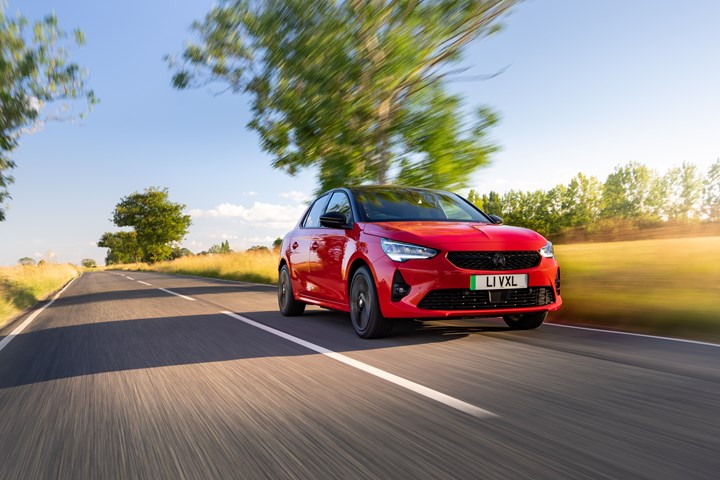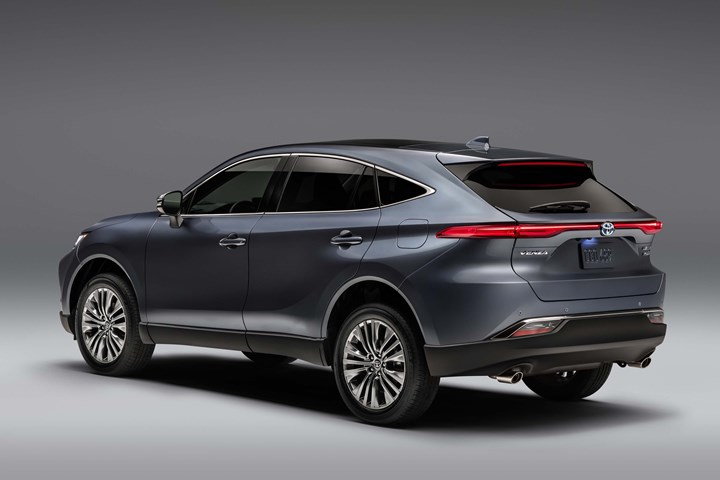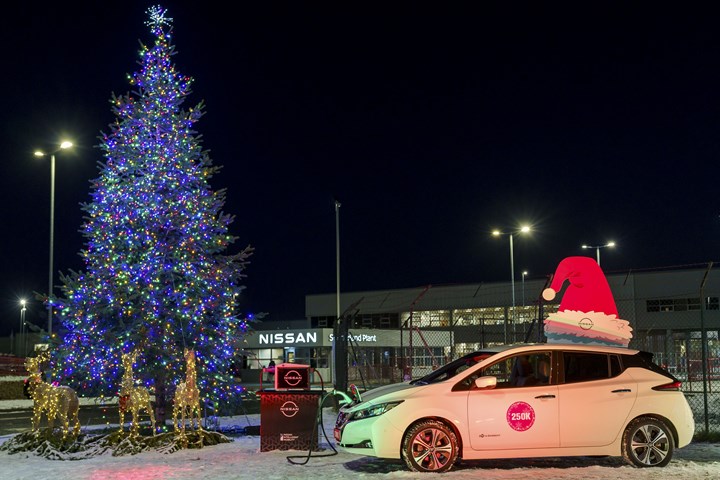on Audi cutting carbon, Infineon deploying chips, & CARB pushing autonomy
Audi in Brussels. . .Infineon looks at auto applications. . .Impact of EV regs on Euro trucking. . .CARB thinks autonomy can help. . .Age and attitudes about auto. . .Auto designer designs watches. . .Toyota Venza review. . .Nissan Sunderland at Christmas. . .
Zero Emissions SUVs Made at Carbon-Neutral Factory: Audi’s Double Win

Building a zero-emissions vehicle in a carbon-neutral plant. (Image: Audi)
Audi initiated production of the new Q8 e-tron at its assembly plant in Brussels last week, where it has been building e-trons since 2018.
One of the notable aspects of the Brussels plant is that it is carbon-neutral—which it has been since 2018.
One notable means by which this is being achieved:
107,000 square meters of photovoltaics, which generates 9,000 megawatt hours of power, enough to charge 90,000 Q8 e-trons.
(Think about that: according to weatherspark.com, “In Brussels, the summers are comfortable and partly cloudy and the winters are long, very cold, windy, and mostly cloudy” and they’re still getting that sort of power, clouds notwithstanding.)
In addition to which, the plant is using renewables for its heat supply.
And “currently unavoidable emissions” are being offset by undertaking carbon-credit projects.
And the Motors, Too
The electric traction motors for the -e-tron are sent to Belgium from an Audi plant in Hungary. It was determined it would be more environmentally beneficial to transport the motors via rail than truck: they’ve calculated that carbon emissions are reduced by about 2,600 tons annually by using this method.
The plant where the motors are built, Audi Hungaria, is the second CO2-neutral plant in the Audi network. It, for example, uses geothermal energy for heating; that method accounts for some 70% of the heating requirements for the plant. The remaining 30% is from natural gas, with biogas certification of its CO2 neutrality. There is also a 160,000-square meter rooftop photovoltaic installation—consisting of 36,400 solar cells—at the Győr plant.
Audi is undertaking an initiative called “Mission:Zero.” This program is meant to make all Audi production operations carbon-neutral by 2025.
Zero-emissions vehicles. Carbon-neutral plants. Audi is taking the environment seriously.
///
Infineon: Right Tech and the Right Time

Peter Schiefer, division president, Automotive, Infineon, sees both electrification and automation of vehicles as a big plus for the deployment of microprocessors. (Image: Infineon)
,
With the increased electrification and level of—call it—operational awareness in vehicles, it is evidently a good time to be in a business like semiconductors because the auto industry just can’t get enough of them (and that might have been the case had their been no COVID-caused chip shortage).
For example, Peter Schiefer, division president, Automotive, Infineon, points out that because silicon carbide (SiC) inverters provide a performance advantage for electric vehicles compared to IGBTs, OEMs are making a transition to SiC in a big way. He estimates that by 2030 SiC will account for 55% of the market. Fortunately for Infineon, this is one of the auto technologies that it has developed and is expanding its manufacturing operations to handle increased demand.
Last month, for example, Stellantis and Infineon announced a MoU through which Infineon would reserve manufacturing capacity that would allow it to supply SiC chips to Stellantis Tier 1 suppliers during the second half of the decade. Stellantis knows that it is going to need those chips and so it is protecting itself with the agreement.
Then beyond power electronics there is the array of processors essential for the operations of essentially all aspects of a given vehicle—even vehicles that have engines rather than motors (e.g., engine control units don’t run on gears), even vehicles that have only minimal levels of advanced driver assistance systems (ADAS).
And for those with increased levels of ADAS. . . .
Advancing Architecture
Schiefer says presently there tends to be a large number of electronic control units that are located in various places around a vehicle. All of these need to be connected other controllers (with plenty of wiring). . .a configuration that doesn’t readily lend itself to what OEMs are looking for as they’re working toward “software-defined vehicles.”
So, Schiefer continues, some OEMs created an architecture based on functions: like functions within a vehicle are organized into a cluster. Even this domain-based arrangement requires a fairly complex wiring harnesses, however.
But there is another approach, one that reduces the amount of wiring involved. It is based on zones: local clusters are created based on where the control units are located in the vehicle.
Schiefer thinks this zonal architecture is the one likely to become dominant. But this is going to be a transition that is not going to happen quickly: he posits that by 2027 20% of the vehicles will be configured with zones, 40% by the end of the decade.
Infineon, of course, has the microcontrollers that lend themselves to this more simplified architecture. And for the more complicated ones, too.
///
Implications of Green Trucks in the EU
The European Automobile Manufacturers’ Association (ACEA) is pleased that the European Commission will revise the maximum weights and dimensions for heavy-duty vehicles, such as transport trucks, and it has some recommendations for the commissioners as they consider the transition of trucks to produce far fewer emissions.
The ACEA points out the commercial vehicle manufacturers in Europe have said they’re working toward zero emissions, but in order to achieve climate neutrality in road transport by 2050 means that new commercial vehicles in 2040 must be zero-emissions vehicles (ZEVs).
But these ZEVs—battery electric and hydrogen-powered trucks alike—have a bit of a problem that the ACEA acknowledges:
The available cargo space can be less than in combustion vehicles and the weight greater.
So ACEA believes that compared with the regulations for traditional trucks:
- All low-emission vehicles should be granted at least an additional 1 ton.
- All zero-emission vehicles should be granted at least additional 2 tons.
Also, the ACEA points out that “new powertrain technologies require more space (e.g., for batteries and tanks” than is the case for traditional trucks that the regulations take into account so it “requests that all zero-emission vehicles. . .are granted additional length of up to 1.5 m.”
And the additional mass “should not be taken into account when calculating road charging rates.”
So the ACEA wants the Weights and Dimensions Directive” to give heavier and longer goods-transport vehicles a pass.
Think About This
One of the things that is going to become a bigger issue as there is a transition to electric vehicles in the U.S. for passenger and commercial vehicles is the revenue generation in light of the reduction of fuel taxes. According to the Urban Institute, in 2019 state and local governments collected $52-billion in motor fuel taxes, most of which were directed to transportation spending, including 26% of highway and road spending.
Reduced fuel means reduced taxes which means. . . .
///
Autonomy & the Environment

The state excise tax for a gallon of gas in California in 2022 is $0.51. Seems that they’re going to have a lot of revenue to make up if this happens. (Image: CARB)
The California Air Resources Board has completed work on its final proposed 2022 Scoping Plan (with two weeks until 2022 is in the rear view, they cut it close).
If the measures laid out in the plan are followed, CARB says that by 2045 the state will:
- Reduce fossil fuel consumption (liquid petroleum) to less than one-tenth of what it uses today – a 94% reduction in demand
- Cut greenhouse gas emissions by 85% below 1990 levels
- Reduce smog-forming air pollution by 71%
- Create 4 million new jobs
- Save Californians $200 billion in health costs due to pollution in 2045 (e.g., cleaner air means easier breathing)
While there is a lot of general attention paid to a ban on sales of vehicles with internal combustion engines in 2035, CARB recognizes that “with 100 percent ZEV sales in the light-duty vehicle sector by 2035, a significant portion of passenger vehicles will still rely on ICE technology” (emphasis added).
It’s not like everyone is going go electric like flipping a switch.
Solo Miles
So to that end, they are also looking at vehicle miles traveled (VMT).
CARB notes, “Driving alone with no passengers remains the primary mode of travel in California.”
It calculates that this accounts for 75% of daily driving.
That means there are a lot of solo VMT.
So among its recommendations—this is something that it doesn’t have the authority to mandate but something that it thinks state, regional, and local transportation agencies and others organizations should consider—is:
- Deploy autonomous vehicles, ride-hailing services, and other new mobility options toward high passenger-occupancy and low VMT-impact service models that complement transit and ensure equitable access for priority populations.
In other words, if you wonder about the efforts that Cruise and Waymo are undertaking in California to provide driverless rides, here’s a reason why.
It isn’t inconceivable that at some point in the not-too-distant future municipalities in California will provide $upport to these autonomous undertakings.
///
Age and Auto Attitudes

The Anniversary Edition of the Corsa Electric. Limited to 1,000 units. The color—“Record Red”—is a tribute to the “Carmine Red” that the original Nova was painted 40 years ago. (Image: Vauxhall)
Vauxhall put its first “supermini” in the U.K. market in 1982, the Nova. Since then there have been over 2.8 million Novas and Corsas (which replaced the Nova nameplate in 1993) sold in the U.K.
So as OEMs are wont to do when celebrating anniversaries, it surveyed 2,000 U.K. adults.
And found some bizarre things.
This Seems Odd
Like 60% saying that they’d like to learn to drive before they turn 40. That’s greater than the 56% who said they want to buy a house before 40.
While getting a license in the U.K. may be more challenging than it is in the U.S., somehow it seems that it would be more understandable were the target age, say, 30 (and even that’s pushing it because you can be licensed to drive at 17).
But before 40?
Here is a rather odd finding in light of that 60%:
57% said they bought their first car at age 25. Did a percentage keep it parked in a garage until they managed to pass the driving test?
What Do People Want?
As for what people are concerned about when looking for in a vehicle:
- <40: Price and safety
- >40: Tech and styling
Funny thing: It seems that when it comes to styling vehicles, the more expressive ones are said to be for young people, not those over 40.
Evidently the younger ones are dealing with a budget and a growing family, so price and safety are paramount. Those older can go for the stuff and the style.
And while 63% of those who are >65 are interested in reliability, only 31% percent of 18 to 24 year olds are.
Perhaps the >65 year olds have already spent more than enough time in dealer repair shop waiting rooms.
///
Another Auto Designer & Another Non-Auto Design

The COSMO line of watches designed by Frank Stephenson. (Image: Frank Stephenson Design)
Frank Stephenson has designed some very fast cars. He led McLaren Automotive’s design ops from 2008 to 2017, so cars from the 720S to the MP4-12C were within his sphere. Before that he’d been the design director for Ferrari and Maserati.
Maserati MC12.
Ferrari F430.
Stephenson.
The Art Center alum decided in 2018 to establish Frank Stephenson Design Consultancy.
And as last week we saw that Ian Callum designed a chair, just in time for the holidays Frank Stephenson has announced COSMOS, his first watch collection.
Stephenson:
“It’s the age-old adage ‘car people are watch people’, so it was a natural step for me to get creative with timepieces too. It was very enjoyable designing COSMOS and I’m proud to debut it to all enthusiasts.
“The collection showcases the love I have for exceptional and emotionally charged design, just like what is required in designing world class cars. We hope that car enthusiasts and those that appreciate unique and compelling design will gravitate to my new watch collection and enjoy wearing them through all of life’s exciting adventures.”
It is interesting to note that as global OEMs are going for the software-defined vehicles, Stephenson has gone old school, with a stainless-steel case and a Japanese quartz movement, not some sort of Apple Phone variant.
///
2022 Toyota Venza Limited

This hybrid-only Toyota Venza has the presence and touches that makes one think it could be a Lexus. (Image: Toyota)
In 1989 Toyota launched Lexus, originally in the U.S. only. The objective was to have a luxury marque added to the company’s portfolio. For example, for those for whom a fully loaded Camry wasn’t as featured as they’d prefer, there was the ES 250. This is not to say that the ES 250 was simply a Camry with more stuff, but that the platforms were shared and they were both sedans. The ES 250 was measurably and stylistically a different vehicle.
Which got me to thinking about the Toyota Venza.
The small crossover is built on the Toyota TNGA-K platform.
It is a hybrid—and only a hybrid—that produces a system horsepower of 219.
It has a 105.9-inch wheelbase; it is 186.6 inches long, 73 inches wide, and 65.9 inches high. It has a passenger volume of 98.3 cubic feet and cargo behind the second row of 28.8 cubic feet.
Not the RAV4
Now there is something that is similar in a Toyota showroom, the RAV4. And while the RAV4 is available with an ICE, there is also a hybrid (and a plug-in hybrid).
The RAV4 is based on the Toyota TNGA-K platform, too.
Its hybrid system produces a system horsepower of 219.
The wheelbase and width are the same as the Venza. It is shorter (180.9 inches) and a bit higher (67 inches).
It has a bit more in the way of passenger volume (0.6 cubic feet more) and quite a bit in cargo volume (37.5 cubic feet).
The thing is this:
The Venza, in exterior and interior styling and execution, is significantly different than the RAV4, and were the badges to be removed from the Venza I would think that I was in a. . .Lexus.
Very Nicely Executed
Yes, there is the Lexus NX, which is also TNGA-K. But we’re talking about someone going into a Toyota store.
Checking the price list, the RAV4 Hybrid Limited AWD, the top-of-the-line trim, has an MSRP of $38,075.
The Venza Limited AWD: $40,730.
So a difference of $2,655.
That’s not nothing, but the Venza “feels” far more upscale.
Clearly, given the cargo advantage that the RAV4 Hybrid has makes it more of a “utility” vehicle than the Venza. And the RAV4 styling—inside and out—are more about a truck-like vibe.
The problem that the Venza has—and I’d argue a problem not at all of its own making (and speaking of making, it is built in Toyota City)—is that it is comparatively invisible compared with the RAV4.
Through the third quarter of 2022 there were 124,153 RAV4 Hybrids sold in the U.S. and just 23,131 Venzas.
Some may vaguely recall that from MY 2009 to 2015 there was a vehicle that can be described as something that resembled a station wagon mashed up with a Ford Edge, the Toyota Venza. It was dropped because of apparent disinterest among those in the market.
However, were those in the market today to be more aware of the current generation Venza, I submit that it would be far more popular than it is.
The Toyota design and engineering teams have done their jobs. Now it is up to Toyota Marketing.
///
Lighting the Tree with a LEAF

The holiday lights at the Nissan Sunderland plant provided by the electric LEAF, which happens to be manufactured in that factory. (Image: Nissan)
While an increasing number of companies are running tests on the vehicle-to-grid power capabilities of their electric vehicles and the grid, the folks at the Nissan Sunderland Plant in the U.K. are doing something with the electric capability of the Nissan LEAF—of which the plant has produced 25,000.
They are using it to power the lights on a 32-foot Christmas tree outside the assembly plant.
Alan Johnson, vice president of Manufacturing in the U.K. said, “Lighting up the Christmas tree with our original EV is a spectacular and appropriate way to end 2022.”
(And while on the subject: all the best for you and yours for the holidays!)
RELATED CONTENT
-
Behind the Chevrolet Bolt
There are some cars that are simply profoundly important than others, and when it comes to cars introduced of late, the Chevrolet Bolt is certainly one of those particularly notable cars.
-
On The Jeep Grand Cherokee, 2022 Nissan Pathfinder, and More
An inside look at the Detroit Assembly Complex-Mack; a innovative approach to waste-free, two-tone painting; why a forging press is like an F1 car; and other automotive developments.
-
on lots of electric trucks. . .Grand Highlander. . .atomically analyzing additive. . .geometric designs. . .Dodge Hornet. . .
EVs slowdown. . .Ram’s latest in electricity. . .the Grand Highlander is. . .additive at the atomic level. . .advanced—and retro—designs. . .the Dodge Hornet. . .Rimac in reverse. . .


.jpg;width=70;height=70;mode=crop)






